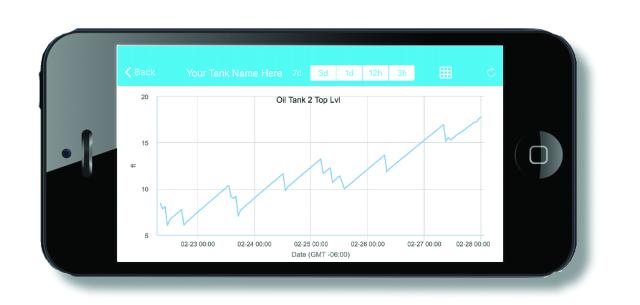
Programs like Zedi Go allow users to monitor tank levels and other field operations from a smartphone. With Zedi Automation as a Service, the company can set up permission levels to assure data are visible only to authorized personnel. (Source: Zedi)
There has been an increase in the pace of the oil and gas industry over the last five years or so. Economic cycles have shortened, and the need for internal speed and efficiency has grown exponentially. With increased speed and efficiency, the requirement to make lightning-fast decisions has become commonplace. This means there is an accelerated time frame to investigate and implement necessary technologies like automation systems.
The industry has already seen software-as-a-service (SaaS) business models work well. By allowing service companies to make the intricate decisions on technology, data acquisition, remote control and more, producers gain time to focus on their core business, which is to explore and produce oil and gas.
Zedi has grown into the SaaS model with automation alongside. A growing number of producers have told Zedi that they want to automate procedures for monitoring and controlling (tanks, pumps, meters, etc.), but they don’t have time to do the research. Zedi can design and install hardware, communication systems and software systems that get producers the data, control and reporting features they need with the speed that is demanded in today’s market. Zedi Automation as a Service (ZAaaS) can be applied to the monitoring of tanks, pumpjacks, gas and liquid flowmeters, gas lift, plunger lift, saltwater disposal or almost any other upstream automation application.
For a producer to execute a project like this, they need to know the best sensors for their tank application—not only for gathering the information accurately but for communicating to a controller and then eventually a SCADA system.
There are many tank sensor technologies and manufacturers; however, there is typically a gold, silver and bronze standard to develop the right solution when economics come into play. Functionally, gold standard technologies are going to be more expensive but more accurate than bronze standard technologies. It takes years of engineering and production experience to know which tank sensor is truly applicable for a given situation.
Choosing the correct sensor does not stop at functionality and price. Communication is key to an efficient solution—Are there cell towers nearby? Is the location so remote that only a satellite modem (more costly but universally available) is the right choice? Even once that’s chosen, there are decisions about the systems reliability, such as the kind of power available at the site and if a solar power system is needed.


With the industry’s need for faster production operations increasing and demand for efficiency growing, ZAaaS helps relieve the potential performance issues and roadblocks of a producer trying to execute on their own. The company’s experience allows it to easily find best practice solutions ready to install immediately in a field, which means automation equipment is up and running in much less time than it would require a producer to navigate complex automation learning curves themselves.
Alongside the ZAaaS model, the company hosts customer SCADA data in the cloud. Like with SaaS, this means customer information and reports are hosted and highly secure. They are safe from a legacy system’s onsite failure and they are available 24-7-365 around the globe to authorized users.
One key factor of this model is that it facilitates scalability. When new wells or other facilities come online, Zedi can quickly and easily add assets into the system. If a client acquires existing production that is already automated, Zedi’s technicians can seamlessly incorporate those data into the cloud-based system. Should a property be sold, the company can work out a way to accommodate either transferring equipment ownership or removal. This makes automation as a service an important strategy when an E&P company is looking to acquire or divest.
It also is important to note that, even though Zedi is hosting, all data belong to the client and the client alone.
The benefits to automation itself are many: instant data availability for a pump on site can decrease downtime and increase production, eliminate environmentally hazardous tank spillage and greatly reduce personnel trips to the site, which improves a team’s safety.
Before automation, a pumper had to drive to every location, whether anything was wrong or not. There was always the chance that it would normally be operating until just after they left, meaning the pump could be offline for 24 hours or more before being noticed at all—potentially costing thousands of dollars in missed production.
With oilfield roads getting more crowded, the safety aspect of reduced windshield time is of growing importance. For a company of any size, automation can reduce road time by thousands of hours per year, returning many of those thousands of hours to employees in productive work time. That is in addition to reductions in vehicle maintenance and repair costs.
Recommended Reading
Exxon CEO Darren Woods: Hydrogen Incentives ‘Critical’ for Now
2025-02-03 - Exxon Mobil CEO Darren Woods said the end goal for energy policy should be a system in which no fuel source remains dependent on government subsidies.
Pioneer to Adapt Emvolon’s Flare Gas-to-Methanol Tech
2025-01-13 - The Department of Energy awarded Pioneer Energy $6 million to demonstrate the technology at an oil and gas facility in the Eagle Ford Shale for 12 months.
Big Spenders: EPA Touts Billions in Clean Energy Spending
2025-01-15 - Nearly $69 billion in funding from the Inflation Reduction Act and Bipartisan Infrastructure Law has been dispersed by the Environmental Protection Agency in its clean energy push.
Report: Trump to Declare 'National Energy Emergency'
2025-01-20 - President-elect Donald Trump will also sign an executive order focused on Alaska, an incoming White House official said.
Comments
Add new comment
This conversation is moderated according to Hart Energy community rules. Please read the rules before joining the discussion. If you’re experiencing any technical problems, please contact our customer care team.



